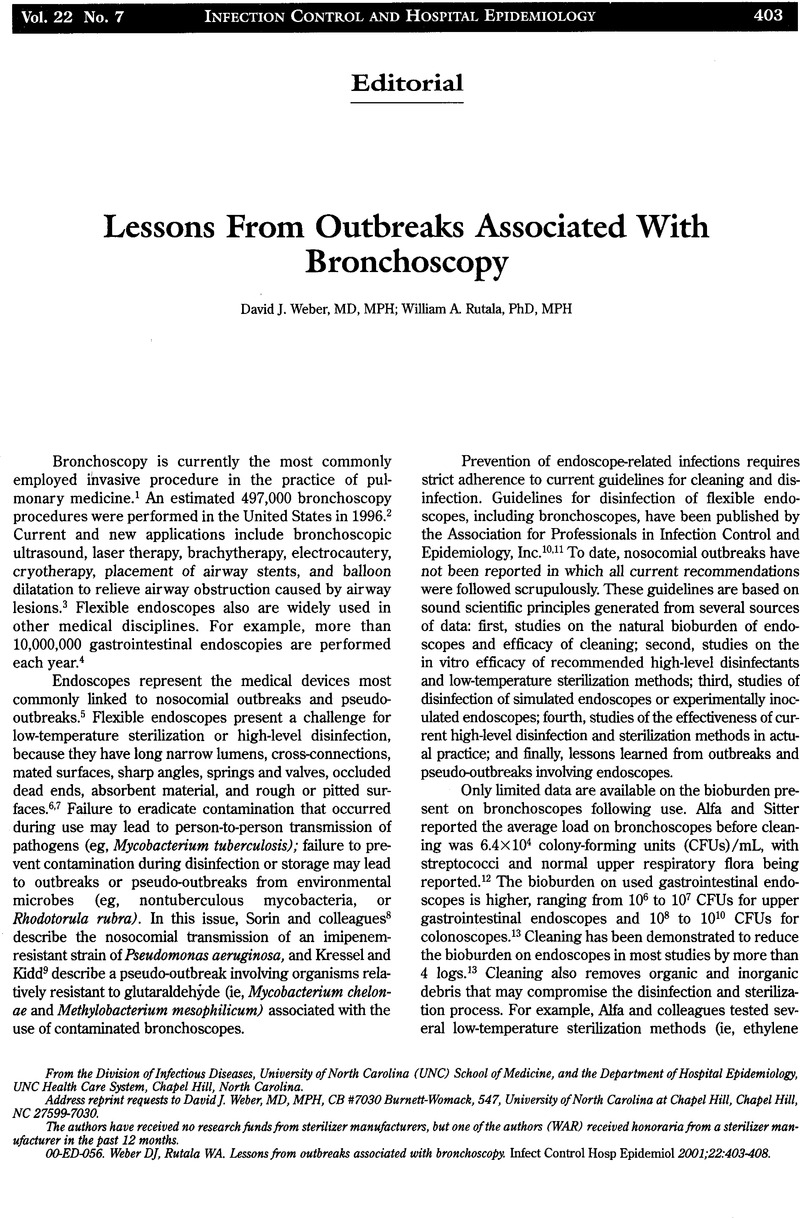Crossref Citations
This article has been cited by the following publications. This list is generated based on data provided by Crossref.
Zühlsdorf, B.
Emmrich, M.
Floss, H.
and
Martiny, H.
2002.
Cleaning efficacy of nine different cleaners in a washer–disinfector designed for flexible endoscopes.
Journal of Hospital Infection,
Vol. 52,
Issue. 3,
p.
206.
Muscarella, Lawrence F.
2002.
Leading a Horse to Water: Are Crucial Lessons in Endoscopy and Outbreak Investigations Being Learned?.
Infection Control & Hospital Epidemiology,
Vol. 23,
Issue. 7,
p.
358.
Srinivasan, Arjun
2003.
Epidemiology and prevention of infections related to endoscopy.
Current Infectious Disease Reports,
Vol. 5,
Issue. 6,
p.
467.
Kirschke, David L.
Jones, Timothy F.
Craig, Allen S.
Chu, Patricia S.
Mayernick, Glenda G.
Patel, Jayesh A.
and
Schaffner, William
2003.
Pseudomonas aeruginosaandSerratia marcescensContamination Associated with a Manufacturing Defect in Bronchoscopes.
New England Journal of Medicine,
Vol. 348,
Issue. 3,
p.
214.
2003.
Recommended Practices for Cleaning and Processing Endoscopes and Endoscope Accessories.
AORN Journal,
Vol. 77,
Issue. 2,
p.
434.
SINGH, NALINI
BELEN, OZLEM
LÉGER, MARIE-MICHÈLE
and
CAMPOS, JOSEPH M.
2003.
Cluster of Trichosporon mucoides in children associated with a faulty bronchoscope.
The Pediatric Infectious Disease Journal,
Vol. 22,
Issue. 7,
p.
609.
Rutala, W. A.
and
Weber, D. J.
2004.
Disinfection and Sterilization in Health Care Facilities: What Clinicians Need to Know.
Clinical Infectious Diseases,
Vol. 39,
Issue. 5,
p.
702.
Rutala, W.A
and
Weber, D.J
2004.
Reprocessing endoscopes: United States perspective.
Journal of Hospital Infection,
Vol. 56,
Issue. ,
p.
27.
Nomura, Kazuyo
Ogawa, Midori
Miyamoto, Hiroshi
Muratani, Tetsuro
and
Taniguchi, Hatsumi
2004.
Antibiotic susceptibility of glutaraldehyde-tolerant Mycobacterium chelonae from bronchoscope washing machines.
American Journal of Infection Control,
Vol. 32,
Issue. 4,
p.
185.
Srinivasan, Arjun
Wolfenden, Linda L.
Song, Xiaoyan
Perl, Trish M.
and
Haponik, Edward F.
2004.
Bronchoscope Reprocessing and Infection Prevention and Control.
Chest,
Vol. 125,
Issue. 1,
p.
307.
Cêtre, J.-C.
Nicolle, M.-C.
Salord, H.
Pérol, M.
Tigaud, S.
David, G.
Bourjault, M.
and
Vanhems, P.
2005.
Outbreaks of contaminated broncho-alveolar lavage related to intrinsically defective bronchoscopes.
Journal of Hospital Infection,
Vol. 61,
Issue. 1,
p.
39.
Weber, David J.
and
Rutala, William A.
2006.
Use of Germicides in the Home and the Healthcare Setting Is There a Relationship Between Germicide Use and Antibiotic Resistance?.
Infection Control & Hospital Epidemiology,
Vol. 27,
Issue. 10,
p.
1107.
Rutala, William A.
and
Weber, David J.
2007.
How to Assess Risk of Disease Transmission to Patients When There Is a Failure to Follow Recommended Disinfection and Sterilization Guidelines.
Infection Control & Hospital Epidemiology,
Vol. 28,
Issue. 2,
p.
146.
Ahn, Gyun Yeol
Yu, Feng Nan
Jang, Sook Jin
Kim, Dong-Min
Park, Geon
Moon, Dae Soo
and
Park, Young Jin
2007.
Pseudo-outbreak of Stenotrophomonas maltophilia Due to Contamination of Bronchoscope.
Annals of Laboratory Medicine,
Vol. 27,
Issue. 3,
p.
205.
Siegel, Jane D.
Rhinehart, Emily
Jackson, Marguerite
and
Chiarello, Linda
2007.
2007 Guideline for Isolation Precautions: Preventing Transmission of Infectious Agents in Health Care Settings.
American Journal of Infection Control,
Vol. 35,
Issue. 10,
p.
S65.
Crawford, Angus
2007.
Decontamination and Traceability of Flexible Endoscopes.
Journal of Perioperative Practice,
Vol. 17,
Issue. 6,
p.
257.
Maki, Dennis G.
Crnich, Christopher J.
and
Safdar, Nasia
2008.
Critical Care Medicine.
p.
1003.
Shimono, Nobuyuki
Murata, Masayuki
Kanamoto, Yoko
Uchida, Yujiro
Matsumoto, Hiroko
Hayashi, Jun
Shimono, Nobuyuki
Takuma, Takahiro
Tsuchimochi, Noriko
Shimono, Nobuyuki
Uchida, Yujiro
Shiose, Akira
Morita, Shigeki
Murata, Masayuki
Kanamoto, Yoko
and
Hayashi, Jun
2008.
An outbreak of Pseudomonas aeruginosa infections following thoracic surgeries occurring via the contamination of bronchoscopes and an automatic endoscope reprocessor.
Journal of Infection and Chemotherapy,
Vol. 14,
Issue. 6,
p.
418.
Oumokhtar, B.
El Houari, H.
Mustapha, M.
Gmira, S.
Mellouki, I.
Benajeh, D.
Aqodad, N.
El Abkari, M.
and
Ibrahimi, A.
2008.
Contamination microbiologique résiduelle des endoscopes digestifs.
Acta Endoscopica,
Vol. 38,
Issue. 5,
p.
483.
Zembower, Teresa
2008.
Editorial Comment.
Journal of Urology,
Vol. 180,
Issue. 2,
p.
592.



